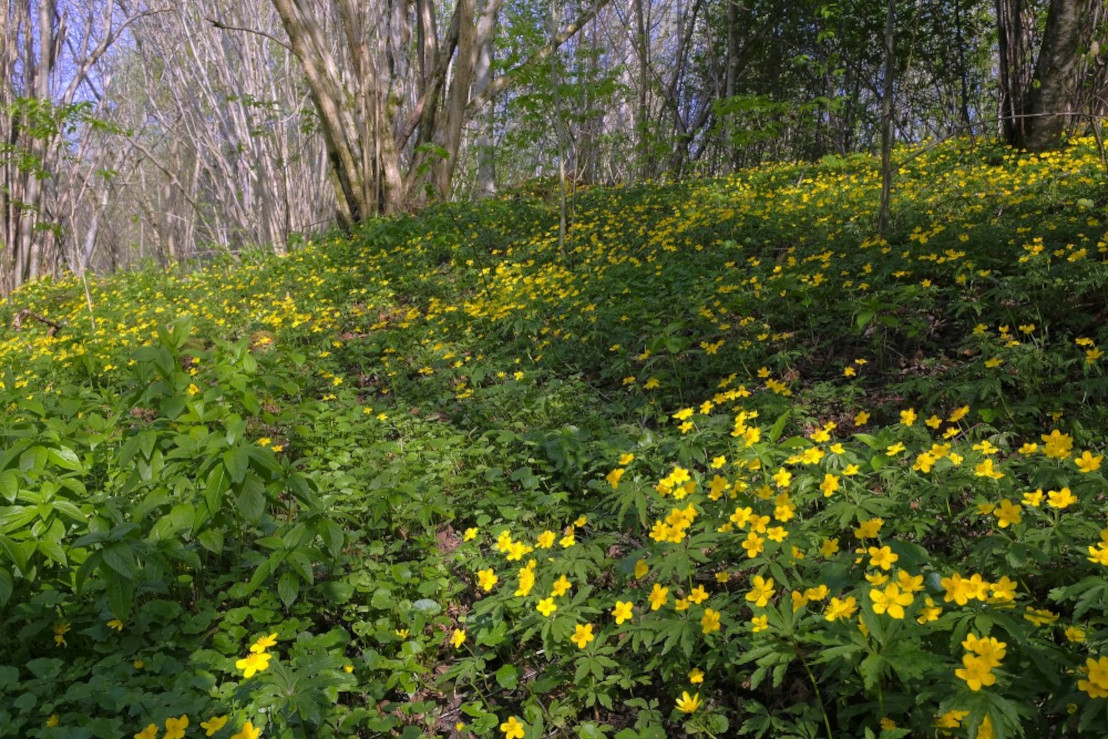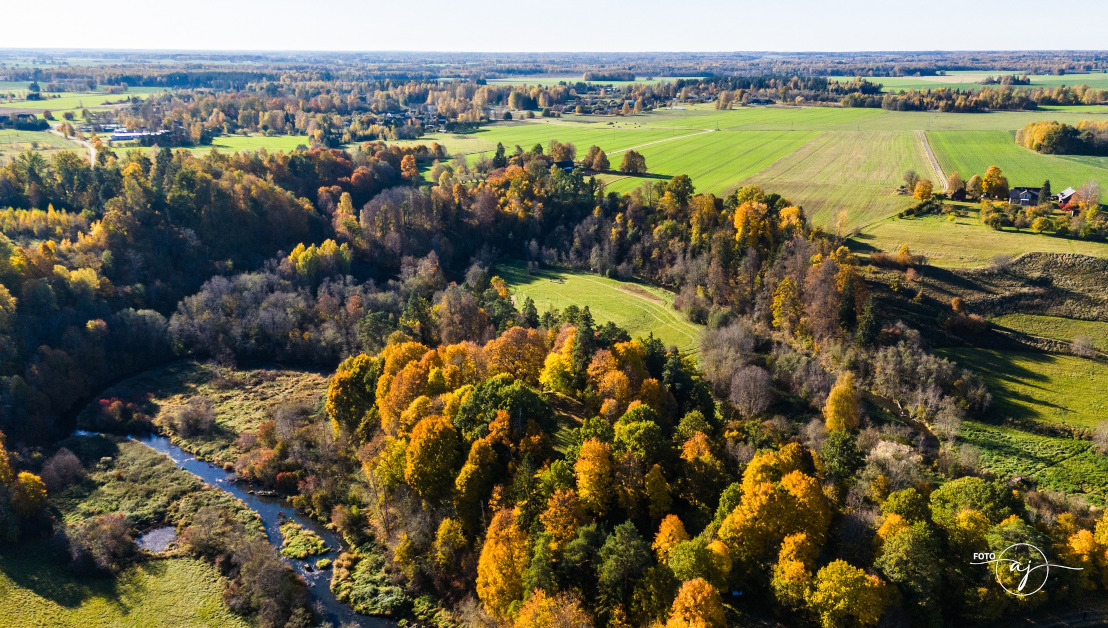Saulgriežu nakts Stirnu buks
In the Land of Forests
Imants Ziedonis, Rimants Ziedonis, © 'Lauku Avīze', 2006.
The Abava River Valley is a well-known tourist destination. Water tourists begin their journeys along the Abava here; people always gather at the Abava Rapids. Picturesque ravines feed the Abava with the Imula and Amula rivers. Here you’ll find the Imula Staburags, also known as Ķauķu Hill, the Veģi, Sudmali, and Īvande waterfalls, the Abava Devil’s Cave and Devil’s Stone, the Zāģeri Devil’s Stone, Māra’s Chambers, Kandava with the oldest stone bridge in Latvia, and Sabile, where Romani children with dark little heads run around.
In the Abava Valley, you can wander along nature trails. If you visit in June, you might see how leaf-rollers have wrapped the bird-cherry trees near the Imula; it looks as if every branch is carefully covered in cellophane. Then suddenly, the caterpillars transform into butterflies—clouds of them burst out from the bird-cherries.
Along the Imula, from “Vītiņi,” where you can pitch a tent and ask the hosts, Aija and Aivars Karnupi, for a glass of water or a piece of firewood, you can hike to the Lankšēde Cliffs, where round, red “Tomcat’s Eggs” (a type of plant) grow, and down in the stream is a questionable “Footprint Stone.” Further along, the trail leads to the Buse Hillfort and then back along the opposite bank—a 5 km hike through forests and meadows, up and down. If you climb the “Star Hills” or “Rose Hills”—each a homestead hill on opposite sides of the Imula—you can see across the valley and imagine that once the waters were bigger here, ships sailed below. The Abava Valley is deep enough to have been navigable—its deepest section, 30–40 meters, lies between the Čāpuli Hillfort and Sabile. The ancient Prussia-Reval trade route passed through the Abava Valley. This was the Vanema land with centers in Matkule, Pūre, Pedvāle, Renda, and others. The owner of Pedvāle, Ojārs Feldbergs, claims to have seen a map in Denmark where the Vikings marked the Abava as a sailing route for their ships.
Along the Abava’s banks, near the former “Pērkoni” homestead and elsewhere, you can still find impressive 200-year-old pines. Undoubtedly, Duke Jacob would have felled them for ship masts; after all, he even considered blowing up the Venta Rapids so ships could pass. Since the early 19th century, Latvia’s mast pines have been famous worldwide as Pinus sylvestris rigensis—the Riga Pine.
The Abava Valley also holds forests, covering much of the nature park territory. The thickest are in the Imula and Amula valleys and downstream from Renda, where the Abava flows through woodlands towards the Venta River. These include biotopes meeting European conservation criteria—ancient natural forests, primary forests in river meanders, slope and ravine forests, wet broadleaf forests, and oak forests. The beautiful oaks along the Abava, Imula, and Amula rivers will surely catch travelers' eyes. These oak groves lead nature researchers to believe that vast oak forests once grew here.
In the forests of the Abava Valley, micro-reserves have been established for black storks, goldeneyes, great black-backed gulls, white-backed woodpeckers, and both ospreys and lesser spotted eagles. Noble and rare bats also fly here—the Nathusius’ pipistrelle, the bearded bat, the Daubenton’s bat, and the pond bat. The valley’s waters are home to graylings, salmon, whitefish, asp, stone loaches, smelt, and mud loaches.

Buses Hillfort
Kārlis Busenbergs owns land where a hillfort stands—the Buses Hillfort, also known as the Matkule Hillfort. Perhaps Kārlis himself should be called the Lord of Buses Hillfort. At home, Kārlis also keeps a notebook written by his father, titled “The Busenbergs: A Lineage of the Lords of Buses Hillfort.” He has a dignified, sturdily bound guestbook, preserved through time, which was started in 1911. Nowhere else can such an old “tourism marketing” relic be found. On the title page of the guestbook, the first entry reads: “In memory of those who visited the Switzerland of Courland. July 16th, 1911. Matkule, Buses.”
Kārlis’s father, Jānis, then a law student, had been advised to start such a book by his fellow student, Ernest Grīnbergs—later the owner of the Štempel Manor in Kandava—and by his friend Visvaldis Čakste, son of the future President of Latvia. They told Jānis, “You already have people constantly visiting to see the hillfort—why not keep a book where they can write down their impressions?” They were also the first to make entries.
The book traces the country’s turbulent history. In 1914, during wartime, the travelers’ entries ceased, and Jānis wrote that the family relocated to the “Dambīši” homestead in the Plāņi parish from 1914 to 1920. Later, the entries resumed with cheerful and prosperous travelers exploring their homeland. Kārlis Ulmanis signed the book as a member of the Constitutional Assembly, and writer Jaunsudrabiņš also left his notes here after wandering through what he called the “Switzerland of Courland.”
In 1938, State Securities Printing House and the Mint employees held a party in the hillfort’s meadow. They noticed the host’s neatly kept guestbook and decided to bring along a finely bound one. Kārlis also remembers the last Midsummer guests at the hillfort in 1941, during the so-called nationalization period, when the Buses estate had to be divided into at least four separate properties. Host Jānis wrote a desperate question in the book: “How to divide Buses?”
Then the German officials arrived to return the nationalized properties to twelve Matkule farmers, neatly recording their actions in the guestbook. Later, Soviet officials arrived. Seeing how precisely the Germans had made their entries, they wrote their own as neatly on the next page.
During World War I, Jānis, a beekeeper, hid the guestbook, silver goblets, and other family valuables in a secret compartment within a beehive. The guestbook remained hidden until 1958, when the hives, already moved to another location, were broken apart as old and useless. But these were honorable people—they returned all the Busenberg family treasures, including the guestbook, to Kārlis, who had just returned from Siberia. “They only asked for one small silver goblet as a keepsake from my father,” Kārlis said. “See—mice have nibbled the photographs.”

In the post-war years, Kārlis didn’t allow anyone to make new entries in the guestbook. But in 1995, during the Midsummer celebration held at the hillfort by Teodors Ķirsis, Kārlis decided that Teodors was the right man to renew this tradition. Kārlis’s son Jānis, a seventh-generation Busenbergs, has climbed mountains with both Ķirsis and Zauls. He also climbed the Himalayas with his father Kārlis.
*"My grandfather Janne, born in 1821, told my father Jānis, born in 1881, all kinds of colorful stories. They lived together for 22 years, and my father wrote everything down. This place was once a fortified settlement. The hillfort maintained connections with the Čāpuļi (or Cikunde) and Kandava ancestral hillforts. When the knights invaded, people fled into the thickets of the Imula Valley. Later, they looked for new places to settle when the regime changed. My ancestors chose Buses. There was a certain reverence for hillforts; no one could pay closer than a verst (about 1 km).
The surrounding houses stand on lands that once belonged to the Matkule Manor, divided after World War I into smallholdings under Ulmanis’s land reform. But 'Buses,' 'Bienes,' and 'Dankumi' are older homesteads. The people of Matkule Parish belonged to the Sabile congregation. My father requested an extract from the church records, which show that our family began living here in 1767. I am the sixth generation..."*
So, standing atop the hillfort, the Lord of Buses, Kārlis Busenbergs, might tell you that across the Imula, which curves around the hillfort, on Baznickalns (Church Hill), a kind of ancient stone pavement was found, and nearby, an ancestral sword was discovered. According to his family’s stories, a drawbridge once connected the hillfort plateau from the side. He will show you the “cup-marked” stone and places where archaeologists have worked.
